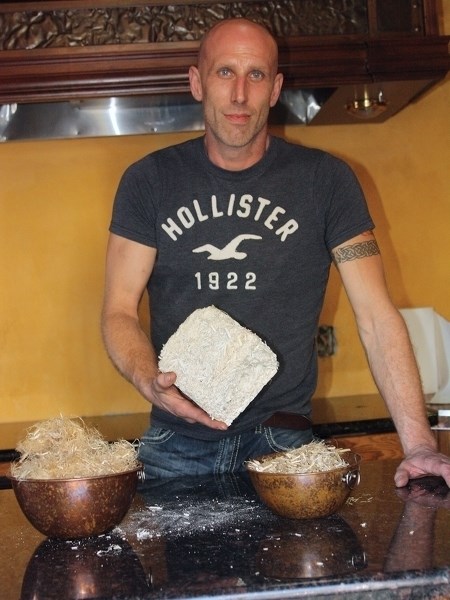After more than three years of hard work and dedication, a Westlock man has put the final touches on his new home.
The result?
Dion Lefebvre is now the owner of a home that breaks the mold of traditional home building — combining condensed living and energy efficiency.
“I think the house has the potential to change the local economy and maybe the whole world,” Lefebvre said.
The 350-square-foot “tiny home” is primarily built with hempcrete, a material made from hemp, combining the plant’s woody core and a lime-based binder. The result is a lightweight concrete-type insulating material.
Lefebvre touts it as potentially the most energy-efficient material, noting that it’s also fire, mould and rot resistant.
“Possibly. I did a lot of research and aside from Earthship Homes, this is he most efficient build that I’ve seen,” he said.
A 25-year veteran of the moving industry, Lefebvre says he was inspired to start the project after his industry exposed him to some of the worst of the construction industry.
“I’ve moved people into brand new homes that I considered quite poor quality, a lot of cheap materials,” he said.
“I wanted to build a safe, healthy place for my kids. I wanted to have a house I could live in forever, a house that would outlive me.”
All in, Lefebvre said he estimates he’s spent about $25,000 to $30,000 on the home.
“A lot of it has been sweat equity. As far as money goes, I’ve had good friends help me with some areas,” he said.
“The cost has been minimal.”
On Saturday, Sept. 24 more than 20 people stopped by to have a first-hand look at the finished product during an open house.
Lefebvre said it was mostly family and friends that stopped by, but noted local realtors also stopped by to take a peek. He said the open house was mainly to show off all his hard work.
“I want to change peoples’ ideology,” he said. “I think everyone should live in one.”
Athabasca’s Andy deLorme was among those to drop by.
“I was amazed. I saw it from pretty much the beginning until the end,” deLorme said.
“We’re going against the grain. It’s nice to see this is a start, at least. A lot more people are going OK, let’s build hempcrete houses in Canada.”
The project hasn’t come without some bumps along the road.
Lefebvre admitted he’s been told he’s crazy more than a few times along the way, but didn’t let it deter him from finishing the project.
Among those that questioned the project was his 14-year-old son Durell, though he has since changed his tune.
“I thought he was crazy when he started. He talked about it for months ahead of time, I thought he was just crazy” Durell said.
Now?
“I’m proud of him. It will be our home for the next 20 to 30 years. It’s just amazing,” he said, though he noted he’s still not too sure about the small size.
“I’m skeptical about the micro house, but I would definitely consider hempcrete for the build material of my house.”
In February Lefebvre got to see just how fire resistant the material is.
“I had a bale of packing paper sitting by a construction light. I left the light on and some time in the night it caught fire,” he said.
Luckily the damage was limited to a corner of the home and didn’t spread because of the fire resistance of the material.
“I wasn’t going to be deterred. I had made my mind up,” he said.
“I did my research about hempcrete and my research about tiny homes.”
For now, the home is connected to electricity, but the eventual goal is to have it powered by wind and solar energy.
The plan is for Lefebvre to live in the home this winter as a trial and after that he intends to buy a property to move it to.
The home is far from the end of Lefebvre’s project. In the future, he plans to build on bunkies to add room for his kids, homes they can “literally take with them” when they move out.
“It’s the way of the future. I really think,” he said.
“It’s an old way of thinking, actually. The Romans used to build with it.”



